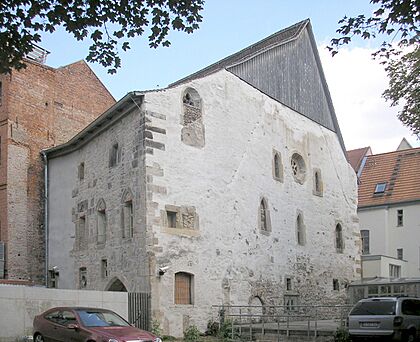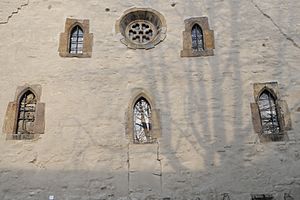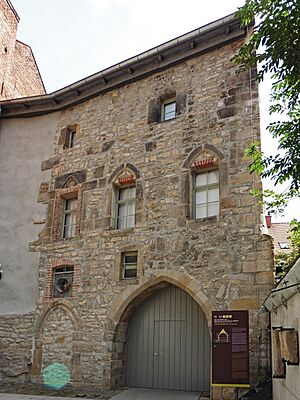Old Synagogue (Erfurt) facts for kids
Quick facts for kids Old Synagogue, Erfurt |
|
|---|---|

The former synagogue, now museum, in 2009
|
|
| Religion | |
| Affiliation | Judaism (former) |
| Rite | Nusach Ashkenaz |
| Ecclesiastical or organizational status |
|
| Status |
|
| Location | |
| Location | Erfurt, Thuringia |
| Country | Germany |
| Architecture | |
| Architectural type | Synagogue architecture |
| Architectural style | |
| Groundbreaking | c. 1094 |
| Completed | early 14th century |
| Official name: Jewish-Medieval Heritage of Erfurt | |
| Type: | Cultural |
| Criteria: | iv |
| Designated: | 2023 (45th session) |
| Reference #: | 1656 |
The Old Synagogue (German: Alte Synagoge) is a very old Jewish building in Erfurt, Thuringia, Germany. It was once a place where Jewish people gathered for worship.
This synagogue dates back to the late 11th century. It is one of the best-preserved medieval synagogues in all of Europe. Most of the building was built between 1250 and 1320. Because its roof is still in place, it is believed to be the oldest synagogue building in the world that is still standing.
Since 2009, the Old Synagogue has been a museum. It tells the story of Jewish life in Erfurt. The museum displays the Erfurt Treasure, which is a collection of old coins and jewelry. It also has copies of important Jewish religious books from the Middle Ages.
The Old Synagogue is considered very important by experts. The Historic Synagogues of Europe project gave it their highest rating. This means it has amazing architecture and history.
In 2023, the Old Synagogue, along with a Jewish bath (called a Mikveh) and a medieval house, became a UNESCO World Heritage Site. This happened because they are so well-preserved. They help us understand what life was like for Jewish communities long ago.
Contents
History of the Old Synagogue
The oldest parts of the building were built in 1094. Scientists used a method called dendrochronology (studying tree rings) to find this out. There was more building work in the 12th century. Part of the western wall with a special double-arched window is from this time.
Around 1270, a larger synagogue was built. It used parts of the older building. The western front of the building, with its five tall, narrow windows and a large round window, was added then. In the early 1300s, the building was made even bigger, and another floor was added.
Changes After the Erfurt Massacre
In 1349, a terrible event called the Erfurt Massacre happened. Many Jewish people were harmed or forced to leave the city. The synagogue was damaged during this time. The city of Erfurt took over the building. Later, they sold it to a local merchant.
The building was then changed into a warehouse. A new cellar was built underneath it. These changes made the inside of the building look very different. For the next 500 years, it was used to store goods.
Rediscovery and Preservation
From the 1800s, the building was used for many different things. It was a ballroom, a restaurant, and even had bowling alleys. Because of these changes, and new buildings around it, the Old Synagogue was mostly forgotten. It was hidden away down a narrow alley. People did not know its history. This actually helped protect it during the Nazi period.
People only started to become interested in the old building in the late 1980s. An expert named Elmar Altwasser began to study it in 1992. The city of Erfurt bought the building in 1998. They carefully studied and preserved it.
Experts made sure to keep all the signs of how the building was used over time. This included its time as a synagogue and later changes. Because of this careful work, you can still see how the building looked in medieval times and how it changed later.
In 2007, archaeologists found a rare and well-preserved Jewish ritual bath, called a Mikveh. It was built around 1250. This bath was found not far from the Old Synagogue. Visitors have been able to see the mikveh on tours since September 2011.
The Old Synagogue Museum
The Old Synagogue opened as a museum on October 27, 2009.
The Erfurt Treasure
The museum permanently displays the Erfurt Treasure. This treasure includes 3,141 silver coins, weighing about 24 kilograms (53 pounds). It also has over 700 pieces of gold jewelry. People believe it belonged to Jewish families who hid it during the 1349 Erfurt massacre.
The entire collection weighs almost 30 kilograms (66 pounds). It was found in 1998 inside the wall of a house. This house was in a medieval Jewish neighborhood near the Synagogue. The Erfurt Treasure has been shown in cities like Berlin, Paris, London, New York, and Tel Aviv.
Erfurt Hebrew Manuscripts
The museum also shows copies of the Erfurt Hebrew Manuscripts. These are important religious texts from the 12th to 14th centuries. The city of Erfurt got these manuscripts after the 1349 massacre. Later, in the late 1600s, they ended up in a library in Erfurt.
In 1880, the library sold them to the Royal Library in Berlin. Today, the original manuscripts are kept at the Berlin State Library.
The Erfurt Tosefta
One of the Erfurt Manuscripts is a copy of the Tosefta. This is a collection of Jewish oral laws. It was written by Jewish scholars who lived around 1 to 200 CE. Many scholars believe the Tosefta helps explain parts of the Mishnah. The Mishnah is the earliest written collection of Jewish oral law.
Copies of the Tosefta are very rare. The Erfurt Manuscript, from the 12th century, is the oldest of only three known Tosefta manuscripts. It is also the second most complete one.
Moses Samuel Zuckermandl was the first person to explain how important the Erfurt Tosefta was. He wrote about it in his study published in 1876.
Other Synagogues in Erfurt
Erfurt has had other synagogues over the years.
The Kleine Synagoge
The Kleine Synagoge (Small Synagogue) was built in 1840. It was used until 1884. This building was restored in 1998. Now, it is used for events. It has a classic style with a beautiful front and inside.
The Große Synagoge
In 1884, the Jewish community built the Große Synagoge (Great Synagogue). It was a grand building with a special Moorish style. Sadly, it was destroyed during the Kristallnacht riots. This was a time of widespread violence against Jewish people and their buildings in Germany, on the night of November 9–10, 1938.
The Neue Synagoge
In 1947, the land where the Great Synagogue stood was given back to the Jewish community. The Neue Synagoge (New Synagogue) was built on this site. It opened on August 31, 1952. The government of East Germany paid for this new building. It was the only completely new synagogue built in that country.
The New Synagogue is still used for worship by the Jewish community in Erfurt today. In April 2000, it was attacked by a group of neo-Nazis.
Gallery
See also
 In Spanish: Antigua Sinagoga (Érfurt) para niños
In Spanish: Antigua Sinagoga (Érfurt) para niños
- History of the Jews in Germany
- Jewish Community of Erfurt
- List of synagogues in Germany
- Oldest synagogues in the world








